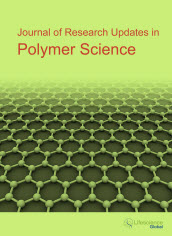jrups
Abstract : Optimizing Activators Regenerated by Electron Transfer for Atom Transfer Radical Polymerization of Methyl Methacrylate Initiated by Ethyl 2-bromopropionate
|
|
Abstract: In this study, we used ethyl 2-bromopropionate (EBrP) as an initiator of activators regenerated by electron transfer for atom transfer radical polymerization (ARGET ATRP) of methyl methacrylate (MMA). We investigated in detail the effect on polymerization of different kinds of reducing agents and ligands, the amounts of the reducing agent and catalyst, and reaction temperature. We determined the molecular weight and dispersity of the polymers by gel permeation chromatography (GPC). The results reveal glucose to be the best reducing agent for this system. The monomer conversion increased with increases in the reaction temperature and in the feeding amounts of the reducing agent and catalyst. The optimum amount of the reducing agent and minimal amount of catalyst required depend on the particular system. For example, we polymerized MMA with 200 ppm of catalyst and 15-fold of glucose/CuCl2 resulting in a PMMA with high Mn (Mn,GPC = 48 700, Mn,theo = 48 500) and low dispersity (1.27). The first-order kinetics show that the molecular weights increased linearly with the monomer conversion and are consistent with the theoretical values, the chain extension reaction and end group analysis results also demonstrate that the characteristics of polymerization process belong to a typical “living”/controlled radical polymerization. Moreover, 1H-NMR analysis results indicate the stereoregularity of the polymer is given priority over syndiotactic architecture and the effect of the type of ligand on the stereoregularity is very slight. Keywords: Ethyl 2-bromopropionate, ARGET ATRP, MMA, reducing agent.Download Full Article |
Abstract : Use of High-Range Water Reducer to Mitigate the Detrimental Effect of Recycled Acrylic-Based Polymers on Concrete Performance
|
|
Abstract: The incorporation of recycled polymers from waste latex paints (WLPs) in concrete manufacturing is very limited. In fact, this practice cannot be formally implemented without thorough assessment of the various implications that could result from WLP additions on concrete properties. This paper seeks to provide better understanding on effect of WLP constituents and substitution rates on concrete fresh and mechanical properties. It also examines the effect of incorporating naphthalene-based high-range water reducer (HRWR) to mitigate the detrimental effects associated with such additions. Tested WLPs were not randomly collected from waste collection sites; rather produced to assure full traceability of composition and then stored for around 1-year to expire. Test results have shown that workability, setting time, and hardened properties of concrete are directly affected by the polymer latex type and content including the pigment/extender ratio. The use of HRWR is efficient to control work ability and its loss over time when WLPs are disposed in concrete at relatively high rate of 10% of mixing water. The incorporation of HRWR should be coupled with certain reduction in free water to control the drop in compressive strength and bond to embedded steel bars. Keywords: Concrete, recycled polymer, waste latex paint, workability, setting time, compression, bond.Download Full Article |
Abstract : Effect of Non-Rubber Constituents on Guayule and Hevea Rubber Intrinsic Properties
|
|
Abstract: To meet the increasing demand for natural rubber (NR), currently sourced from the tropical rubber tree Hevea brasiliensis, and address price volatility and steadily increasing labor costs, alternate rubber-producing species are in commercial development. One of these, guayule (Parthenium argentatum), has emerged on the market as a commercial source of high quality rubber. Non-rubber constituents play an important role in the physical properties of NR products. The intrinsic composition of the two NR materials differs and these differences may be a principal cause of the performance differences between them. We have compared the effect of non-rubber constituents, such as protein, lipids, resin and rubber particle membranes. Firstly, a film casting method was developed to obtain rubber films with a uniform thickness. Secondly, the glass transition temperature of different rubbers was determined by dynamic mechanical analysis, and tensile properties were tested for uncompounded materials. Guayule natural rubber (GNR), from which most of the membranes were removed while in latex form (MRGNR) was found to have higher intrinsic strength than GNR or gel-free NR (FNR). An acetone extraction was performed to quantify the resin and free lipids in the rubber samples. Keywords: Guayule, Hevea, natural rubber, protein, resin.Download Full Article |
Abstract : A Review of Backup Mechanism for Reducing Delamination when Drilling Composite Laminates
|
|
Abstract: Over the past decades, composite materials have been increasingly utilized in various industries because of their superior mechanical properties and resistance to corrosion. Drilling is essential to produce precise holes when load-carrying structures are produced using composites. Because of the non-homogeneous andanisotropic property of composite laminates, delamination often occurs at the point where the drill exits, which affects reliability and safety. Some studies present a suppressed mechanism to prevent delamination when drilling composite laminates. The experimental results demonstrate delamination is significantly reduced by various suppressed mechanisms and greater feed rates produce the same level of delamination. The use of special drill geometries and backup has been demonstrated to be more advantageous than the use of adapted feed controls. The basis for the future development of a suppression mechanism for drilling composite laminates is determined. Keywords: Composite materials, Drilling, Delamination, Suppressed mechanism, Backup.Download Full Article |






















